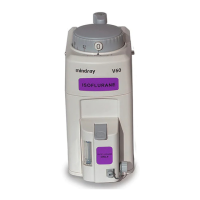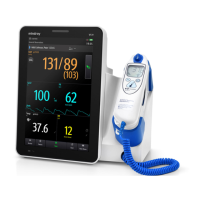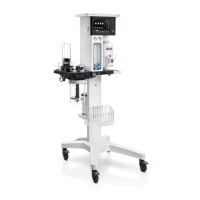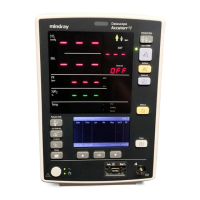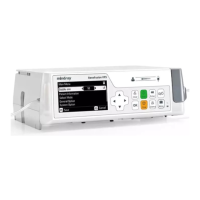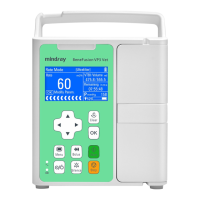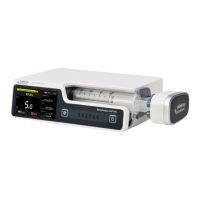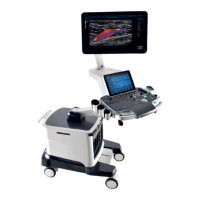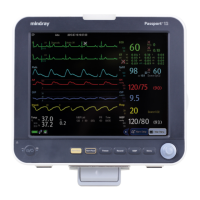V Series Operating Instructions 14 - 7
Non-Invasive Blood Pressure (NIBP) Measuring NIBP
• The cuff should be applied so that the center of the bladder in the cuff is over the brachial artery.
Use the reference marker for this.
• For best results, the cuff should be placed on the arm at heart level and the lower arm supported
passively. Published data indicates that BP can increase about 2 mmHg for every inch that the cuff
is below heart level and decrease by the same amount if above heart level.
• Avoid compression or restriction of the pressure hose. Do not place the NIBP cuff on a limb that is
being utilized for any other medical procedure, for example, an I.V. catheter.
• Have the patient sit quietly for several minutes before BP measurement and remain still during
measurement to avoid unnecessary motion artifact. If the patient has not rested before
measurement, BP could be elevated by 10 to 20 mmHg.
• Do not talk to the patient during BP measurement as talking has been shown to result in a 10 to
15 mmHg overestimation of BP.
• The patient’s back and feet should be properly suppThe patient’s back and feet should be
properly supported with the legs kept uncrossed. Unsupported back and feet could increase BP
by up to 15 mmHg, while crossed legs could result in a 4 to 12 mmHg increase.
• Other factors that have been shown to result in an overestimation of BP are labored breathing (5
to 8 mmHg), full bladder (10 to 15 mmHg), pain (10 to 30 mmHg).
References:
• American Association on Critical-Care Nurses (AACN): Practice Alert, Non-Invasive Blood Pressure
Monitoring (April 2010)- http://www.aacn.org/wd/practice/docs/practicealerts/non-invasive-bp-
monitoring.pdf?menu=aboutus
• Pickering Thomas G, Hall John E, Appel Lawrence J, Falkner Bonita E, Graves John, Hill Martha N,
Jones Daniel W, Kurtz Theodore, Sheps Sheldon G, Roccella Edward J. Recommendations for
blood pressure measurement in humans and experimental animals: Part 1: Blood pressure
measurement in humans: A statement for professionals from the Subcommittee of Professional
and Public Education of the American Heart Association Council on High Blood Pressure
Research. J Hypertens 2005; 45: 142-161.
• O’Brien Eoin, Asmar Roland, Beilin Lawrie, Imai Yutaka, Mallion Jean-Michel, Mancia Giuseppe,
Mengden Thomas, Myers Martin, Padfield Paul, Palatini Paolo, Parati Gianfranco, Pickering Thomas,
Redon Josep, Staessen Jan, Stergiou George, Verdecchia Paolo. European Society of Hypertension
recommendations for conventional, ambulatory and home blood pressure measurement. J
Hypertens 2003; 21: 821-848.
TABLE 14-2 Guidance Table
CUFF DESCRIPTION LIMB CIRCUMFERENCE
Child 10 to19 cm
Small Adult 18 to 26 cm
Adult 25 to35 cm
Large Adult
33 to 47 cm
Thigh 46 to 66 cm
Adult Long 25 to 35 cm
Large Adult Long 33 to 47 cm

